Marktech Optoelectronics
3 Northway Lane North
Latham, NY 12110
Fax: +1-785-4725
Email: info@marktechopto.com
The broadest line of both silicon and InGaAs detectors commercially available.
Indium Gallium Arsenide (InGaAs) PIN photodiodes are made using InGaAs/InP technology.
Cutting-edge silicon photodetectors that excel in precise detection of light ranging in wavelength from 250nm to 1100nm
Monolithic “quads” or quadrant photodiodes (QPDs) are 2 X 2 photodiode arrays with four planar diffused photodiode elements or segments.
Marktech offers a broad line of silicon photo Transistors in a variety of package types ranging from miniature metal can to ceramic packages.
Our High-Reliability Photoreflectors are sensors that contain both the LED emitter and photodetector functions within a single package.
Marktech Si APD’s offer low-level light and short pulse detections of wavelengths between 400 nm and 1100 nm.
UV detectors are offered in a variety of TO metal-can type packages from TO-18 to TO-39 with special UV glass lens to insure optimum lifetime and the least amount of material degradation
With the ability to detect light in the UV, visible, and infrared spectrums, photo detectors, photo transistors, and photodiodes are being used in increasingly more applications.
Marktech offers the broadest range of emitters commercially available ranging from 235nm to 4300nm across the UV, visible, NIR, SWIR, and MWIR spectral ranges.
Marktech offers the broadest range of UV LEDs commercially available ranging from 235nm to 400nm including UVA, UVB, UVC, and deep UVC LEDs.
Our advanced line of visible LED products is engineered to deliver high-quality, energy-efficient lighting solutions across various applications from 400nm to 700nm..
Our NIR LED wavelength range is typically from 700nm to 1000nm, extending into wavelengths invisible to the human eye but crucial for numerous technological and scientific applications.
Our standard product offering includes wavelengths from 1020nm to 3000nm and operating currents ranging from 20mA to 350mA for high-power applications.
Our Point Source LEDs are specifically engineered for optical encoders, edge sensors, and other critical applications that demand highly focused light with minimal dispersion.
Multi-LED chips in a single package, our multiple wavelength LEDs are engineered to address a myriad of applications across the UV, visible, NIR, SWIR, and MWIR spectral ranges
Designed to produce a highly defined red dot or reticle, facilitating accurate aiming without revealing the location to the target.
Ideally suited for applications including edge sensing, line sensing, coin bill validation, and bar code reading
Our panels are crafted to deliver uniform, vibrant illumination across a wide range of applications, from consumer electronics to industrial displays.
Crafted with the latest LED technology, these rings provide adjustable illumination to meet specific needs, ensuring optimal visibility and enhancing the quality of your projects.
As a proud CREE LED Solution Provider for over a decade, Marktech offers comprehensive engineering support, including design, binning, and material selection, alongside custom packaging options for specialized applications.
CREE LED through-hole emitters, designed for high-temperature and moisture environments with UV-resistant optical-grade epoxy, offer a range of colors for versatile applications in signage and lighting.
CREE High Brightness (HB) SMD LEDs are the brightest, most reliable architectural, video, signage, scoreboard, roadway, and specialty LEDs available today.
CREE LED’s P4 series represents a leap in LED design, combining efficiency with aesthetic versatility to meet the demands of modern lighting applications.
Marktech’s CREE LED XLamp® offerings on aluminum core starboards simplify LED integration for designers, providing a range of colors and angles on compact boards for easy testing and implementation in varied lighting applications.
Marktech Optoelectronics introduces its new product line of CREE LED die, including the EZ1350 Series Die, packaged in TO-cans (TO-18 and TO-39 outlines) designed for precision and reliability in demanding applications with protection against environmental factors like moisture and dust.
Marktech Optoelectronics combines over 40 years of expertise in optoelectronics with a focus on customized engineering solutions, addressing specific customer needs and applications.
Custom photodiode detectors are designed to meet unique customer requirements, offering specialized performance features and cost savings through optimizations such as integrated filters, photodiode arrays, and hybridization.
Through our vertically integrated manufacturing facilities in California and Japan, we offer custom LED solutions, including packaging and optoelectrical categorization, enhancing product design and market readiness.
Multiple LED dies combined in a single package are engineered to address various applications across the UV, visible, NIR, SWIR, and MWIR spectral ranges.
To succeed, you need the exact optoelectronic package custom-designed and manufactured for your application, including hermetic metal SMD, TO-can, plastic SMD, and molded through-hole packaging.
Made-to-order semiconductor chips (die) and wafers are designed and fabricated to fit your needs. Standard dies are available in specific wavelengths for high-volume production applications.
Bare and encapsulated LEDs, photodiodes, and other components are assembled on FR4, metal-cored, and flexible circuit boards, ready for production.
Learn about the latest trends, devices, and potential applications.
The latest news and announcements from Marktech Optoelectronics.
Detailed information about common uses for Marktech Optoelectronics devices.
In depth discussions on LEDs, Detectors and the science behind them.
Become familiar with common terminology and concepts for LED Devices.
List of common concepts and definitions for Photodiodes.
The features of LED lamps become clear by comparison with tungsten filament incandescent lamps and discharge tubes in their light emitting mechanisms and structures. The following are some qualities of LEDs lamps:
application ParameterPerformance Light transmittivity (Visible ray area)80% – 90% Glass transition temperature (Tg)Approx. 140°C Coefficient of linear expansionApprox 7 X 10 -5 /°C Elastic modulus of bendApprox. 300kg weight/mm2 Moisture absorbtion at boiling (24 hours).
Maximum ratings – Maximum ratings refer to one that cannot be exceeded in any instance under designated conditions. No product guarantees that two or more parameters of maximum ratings can be met simultaneously. As a supplement to maximum ratings, some products list ambient temperature vs. allowable forward current (or power dissipation) characteristics, as exemplified in figure 3-2-6. Table 3-1-3 lists an example of maximum ratings specification.
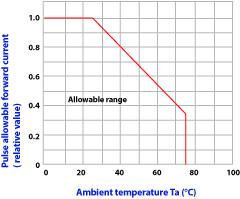
Figure 3-2-6
Soldering – The softening temperature of the resin of which the LEDs packages are made is generally low; less than about 100°C. The following table lists the different soldering methods and conditions:
Soldering work conditions – Unless otherwise specified in the technical documentation, perform soldering work under the following conditions.
Soldering Temperature: 260°C or less (when solder dipping) 300°C or less (when hand soldering) (note)
Working Time: Within 3 seconds
Place to solder: 2mm or more from the root of the terminal
Note: When using a soldering iron, be sure to use a soldering iron with capacity of 30W or less and adjust the supply voltage so that the iron tip temperature is 300°C or less.
As long as soldering work is performed under these conditions, most problems such as reduction in light amount, opening or shorting, or mold breakage due to soldering heat can all be prevented.
If one or more of the above conditions cannot be followed for reason of available space or relationships with other components, take caution not to apply stress to the lead wires during solder dipping work and prevent increases in temperature from being conveyed to the device ( in places above the root of the lead).
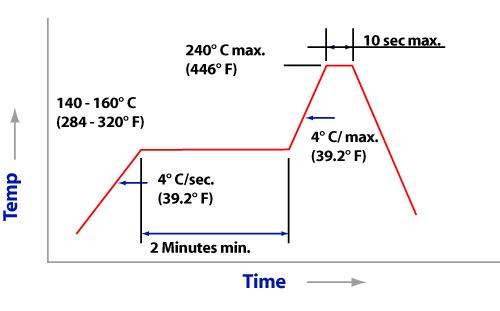
Surface mount soldering
Reflow Soldering: It is recommended to use a reflow furnace with an upper and lower heater:
Precautions for Mounting: Do Not apply force to plastic part of LEDs when LEDs is under high temperature. Avoid contact friction between LEDs and other components during the assembly process as this may damage the plastic portion of the LEDs.
Recommended Soldering Patterns: TLx1005 Series TLx1002 Series MTSMx35K-xx Series

Washing – When the devices are washed in chemicals for removal of flux after soldering, the use of unsuitable chemicals may result in a change in quality and color, and even cracks in the packages. The recommended chemicals for washing Marktech visible LEDs lamps are: Chlorothene, Freon TE or TF, Dai-Fron Solvent S3 or S3-E. For washing LEDs Luminators (MTBLx41x-XX), use water only.
When the devices are ultrasonically washed in these chemicals, use an ultrasonic washing machine that has an output power of less than 300W; do not resonate the devices attached to the board. It is also strongly recommended that the printed circuit board does not touch the oscillator and the devices are washed in less than 30 seconds.
Since the optical output of a light-emitting diode depends on the LEDs forward current IF, you can easily implement a circuit to turn the optical output on and off by controlling the forward current. The following describes the typical methods of lighting – DC lighting, pulse lighting, and AC lighting – and some precautions to be observed when designing.
Figure 3-1-7 depicts a basic circuit to light the LEDs by using a DC power supply. In this case, IF is expressed by the equation:
IF = (VCC – VF ) / R where
VCC = supply voltage
VF = forward voltage of LEDs
IF = forward current flowing in LEDs
Figure 3-1-8 shows a circuit where variations in VF of an LEDs is compensated for by a transistor. In this case, If is expressed by the equation:
IF = (VB – VBE) / R3 where
VB = base voltage
VBE = voltage between base and emitter R3 = emitter resistance
With this circuit, the temperature dependency of the optical output can be reduced by setting VBE and VB appropriately.
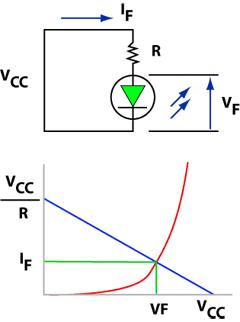
Figure 3-1-7
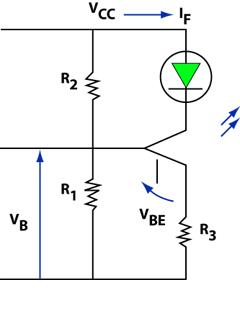
Figure 3-1-8
If the radiant power output is insufficient, the problem can be solved by connecting a diode in series or parallel to the other. In this case, If is expressed by the equations:
IF = (VCC – NVF) / R (series connection)
IF = (VCC – VF) / R (parallel connection)
Figure 3-1-10 depicts a basic circuit to light the LEDs to approximately a half-wave by using an AC power supply. Generally, there are two drive methods, (a) and (b). In either case, a protective diode is used to prevent the LEDs from being subjected to a voltage greater than its reverse withstand voltage.
For (a), this protective diode must have a reverse voltage that corresponds to the supply voltage, VCC. For (b), the protective diode must have a reverse withstand voltage of approximately twice the forward voltage of the LEDs.
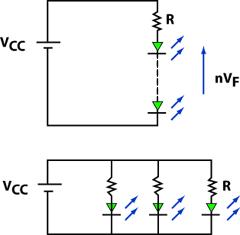
Figure 3-1-9 – Increasing radiant power
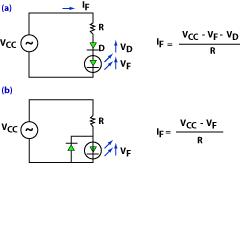
Figure 3-1-10 – AC lighting circuit
Here, the circuit constant. R, must be one that has the appropriate rated voltage according to the supply voltage VCC. Also, R is determined so that the forward current of the LEDs IF is held to within the rated value at a point where the supply voltage VCC is maximum.
Pulse drive method: This pulse drive method is designated by using a TTL gate or a combination of CMOS and transistors. The advantage of converting optical signals into pulse-modulated light by pulse lighting is that if the device is powered by a battery, the useful life of the battery is extended since the device’s power consumption can be reduced.
Figure 3-1-11 calls for attention to the IOL electrical characteristics of TTL and CMOS. For If < IOL to be met, these circuits do not allow large current to flow.
To increase the drive current, it is necessary to use a buffer IC with a greater output current capacity or connect an external transistor as shown in Figure 3-1-12.
The following lists the IOL and VOL characteristics of typical TTL, CMOS, and buffer ICs for your reference.
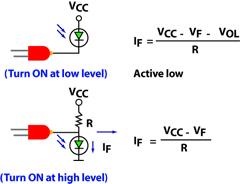
Figure 3-1-11 – IC-based lighting circuit
VIS IC Lighting Circuit With Buffer
Figure 3-1-12 – Lighting circuit using IC & buffer transistor
Other pulse lighting circuits: Various pulse generator circuits may be considered as the pulse lighting circuits. In most cases, however, the pulse lighting circuits can be configured easily by using multivibrators or UJTs.
The pulse allowable forward current IFP when an LEDs lamp is driven by applying a periodic square pulse like the one shown below is listed in Table 3-1-4.
Note, however, that the maximum allowable value must be consulted to obtain the correct value
IFP = pulse allowable forward current
PW = pulse width
T = repetition period
DR = duty ratio (PW / T)
If the ambient temperature (Ta) exceeds 25°C, derating of IFP for Ta (shown in Figure 3-1-13) is required.
Pulse Driving – With the exception of GaP red, optical characteristics in the high-power zone are excellent, permitting effective pulse driving. Since permissible pulse forward current varies depending on driving conditions, refer to the characteristic diagrams as follows. Also, during DC driving, derating is similarly required against ambient temperature.
Precautions on Mounting – Mounting on printed circuit boards (PC boards): Printed circuit boards are the typical method of mounting used for optical semiconductor devices. The following describes the recommended methods for mounting each device classified by type and several precautions to be observed when mounting these devices.
Precautions to be taken for specific type For plastic type: When mounting this type of device on a 2.54mm-pitch standard PC board, solder the device to the PC board 2 mm or more apart from the root. *PW = 100μs, DR = 10-1

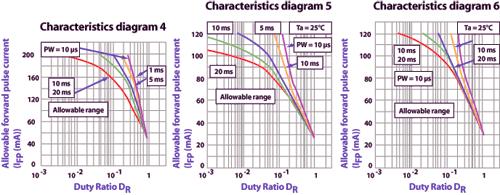
Also, take care not to forcibly press the device against the board. Even when mounting on a pitch-compatible board, solder the device 1 mm or more apart. In the case of through-hole boards, however, the device must be fitted 2 mm or more above the board surface.

For subminiature axial type: Unlike the standard stand-alone type, there are two methods of mounting for the double-end subminiature type: a method of mounting from the surface of the circuit board ( Figure 3-1-14) and a method of mounting from the reverse side (Figure 3-1-15).
In the former case, a good method of mounting is if possible, open a hole in the PC board to fit the plastic bottom part and position the device there, so a deviation in the optical axis can be minimized. However, there is a precaution to be observed. Never solder the device after forcibly pushing it into the hole or while being subjected to mechanical stress (Figure 3-1-16).
Figure 3.1-14
Also note that this type of device is very small and therefore has its resin temperature rapidly increased when soldered. To prevent this problem, nip the lead wire with nippers or tweezers to radiate heat during soldering work.
Figure 3.1-15
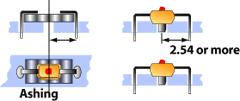
Figure 3.1-16
Handling Precautions
Wear Resistance: Molded devices use a plastic of relatively low hardness since they require a clarity of lens. Therefore, friction with metal or your finger nail must be avoided.
Heat Resistance: The plastic section may be discolored if subjected to heat for a long time. Therefore, make sure that the device is not exposed to temperature environments where their storage temperature is higher than the rated value.
Mechanical Stress in lead wire: If the lead wire is soldered while being subjected to stress, or tensile, torsional, or compression stress is applied between lead wires while hot immediately after soldering, open circuits may be generated inside the device. Therefore, be sure to correct the position and direction as necessary, after sufficiently cooling.
About the forming:
Stand alone type: While holding the lead near the root with nippers do not put stress on thead root, bend the lead at its constricted part or a position 2 mm or more apart from the root.
Double-end type: Bend the lead at its constricted part or a position 2 mm or more apart from the root.

Characteristically, the luminous intensity of LEDs gradually decreases over the life of the LED. The rate at which the luminous intensity falls varies according to the material used and the forward current at which the LED is driven. The larger the current, the greater the diminution of luminosity. Thus, when setting the forward current of the LED lamp, do not determine the setting solely from the temperature characteristics, as in the above example, but consider also longevity characteristics. An effective way of improving the longevity characteristics is to set the forward current of the LED lamp relatively low.
It is the purpose of this section to introduce the periodic reliability reports issued by Marktech on our optoelectronic products.
As new products, processes and test procedures evolve, the applicability of past data to reliability changes. Thus, data presented here represents a “snapshot in time” of data believed applicable to the product made now and in the immediate anticipated future.
1. Led lamps and led displays
Reliability Tests:
Reliability Tests are conducted to confirm the design margin and limit levels of devices, or to maintain and confirm the quality assurance levels of mass produced devices.
Though the test methods and test conditions depend on the purpose usually, the electrical stress, thermal stress and mechanical stress during the use of the devices are assumed and their withstand levels are estimated.
Table 3-1 shows the reliability test method of LEDs and led displays.
| Type | Test | Test conditions | MIL-STD-750 Reference |
|---|---|---|---|
| Life | Operating life | Ta = 25°C IF Max. rating | 1026.3 |
| Life | High temperature storage | Ta = Tstg., Max. | 1026.3 |
| Life | Low temperature storage | Ta = Tstg., Min. | – |
| Life | High temperature and high humidity storage | Ta = 60°C or 40°C, R. H. = 90° | – |
| Enviromental | Immersed for 10 sec. at 260° up to 2mm from the body | 2031.1 | |
| Enviromental | Tstg. Min. ~25°C~ Tstg. Max. ~25°C (30 min.) (5 min.) (30 min.) (5 min.)  | 1051.1 | |
| Enviromental | 100°C or Tstg. Max. ~0°C  3 sec. transfer in water | 1051.1 | |
| Enviromental | Moisture resistance |  | 1021.1 |
| Enviromental | 100~2000~100 Hz 4 cycles each X, Y, Z at 20G  | 2056 | |
| Enviromental | 3 blows, 1500G, 0.5 (lamps) 3 blows, 500G, 1 ms (displays) | 2006 | |
| Enviromental | 1 minute each X, Y, Z at 20,000 (lamps) 1 minute each X, Y, Z at 5000G (displays) | 2006 | |
| Enviromental | Weight 250 g, 0° ~ 90° ~0° bend, 3 times | 2036.3 | |
| Enviromental | Immersed for 5 sec. at 230°C flux: 75% isopropyl alcohol, 25% WW resin | 2026.2 |
Reliability test methods – life tests
| Measuring terms | Failure criteria |
|---|---|
| Luminous Intensity(IV) | Lower standard limit X 0.5 |
| Forward voltage(VF) | Upper standard limit X 1.2 |
| Reverse leakage current (IR) | Upper |
Operating Life Test: To confirm the stability during usual operation, the maximum rating forward current at room temperature is applied to the LEDs.
Storage Life Test: To confirm the stability in storage, the high and low temperature storage life tests are conducted under the conditions of the maximum and minimum storage temperature. Since the devices may be used or in storage at high temperature and high humidity, therefore the high temperature and high humidity storage life test is conducted.
Environmental Test: Since the estimation of thermal stress and mechanical stress applies to the rating, the attaching and using of the devices, the soldering heat, temperature cycles, thermal shock, vibration and lead strength etc. are examined.
*PW = 100μs, DR = 10-1
Reliability test data – The measuring terms and failure criteria are as follows:
Prediction of Failure Rate
Based upon field experience and our extensive test data, the failure mode when using LEDs are dominated by accidental failures (open, short, etc.) rather than the degradation of the luminous intensity. These accidental failures are considered to result from, carelessness in the manufacturing process; fatigue due to the thermal stress and mechanical stress etc.; breakdown due to over voltage (current). Accordingly if we take into account these accidental failures, the failure rate can be predicted.
From our field experience and our extensive test data, this accidental failure rate can be estimated to be about 10 to 50 Fit.
Regarding the luminous intensity (IV) which is the main characteristic of LEDs, the half-life (time when the luminous intensity has been reduced to 50% of the initial value) obtained from the accelerated operating life test, is estimated as shown in Figure 3-2.
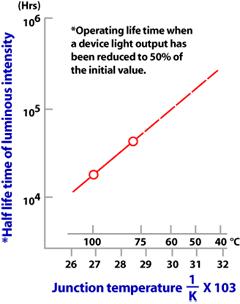
Figure 3-2 – Junction temperature
Marktech Optoelectronics
3 Northway Lane North
Latham, NY 12110
Fax: +1-785-4725
Email: info@marktechopto.com